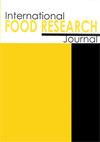Konjac gum and maltodextrin compound tablets as carriers of IgY for sustained release in stomach
IF 1
4区 农林科学
Q4 FOOD SCIENCE & TECHNOLOGY
引用次数: 0
Abstract
Egg yolk immunoglobulin (IgY) is a biologically active ingredient with high immunogenicity; however, its instability in the acidic environment of the upper gastrointestinal tract limits its application in oral formulations. In the present work, an encapsulation system based on maltodextrin (MD) and konjac gum (KGM) was developed as a protective carrier for IgY for targeted release to retain stability. A simulated gastric model was used to compare the release characteristics of the different formulations, and to explore the optimal release mode. To better understand the controlled release mechanism of MD and KGM composite tablets, the release curve, macrostructure, microstructure, and water mobility were analysed. Results indicated that the sustained release of IgY from MD and KGM composite tablets was mainly driven by Fick diffusion and dissolution. As the concentration of KGM increased, the release rate of IgY from the tablets decreased, and the release mechanism gradually changed from diffusion to erosion. The dense cross-linkage between MD and KGM helped prevent tablet disintegration, and slowed down the release of IgY. In addition, the dissolved KGM formed a film on the tablet surface to control the erosion rate. It can be concluded that the optimal formulation of an IgY-loaded tablet was a mass fraction of 50% MD, 30% KGM, and 20% IgY. The present work provided a practical method to protect the biologically active ingredients from acidic destruction in the stomach during oral treatment.魔芋胶麦芽糖糊精复合片作为IgY胃内缓释载体
卵黄免疫球蛋白(IgY)是一种具有高免疫原性的生物活性成分;然而,其在上消化道酸性环境中的不稳定性限制了其在口服制剂中的应用。本研究以麦芽糖糊精(MD)和魔芋胶(KGM)为基础,制备了IgY靶向释放的包封体系,以保持IgY的稳定性。通过模拟胃模型比较不同剂型的释放特性,探索最佳释放模式。为了更好地了解MD和KGM复合片剂的控释机理,对其释放曲线、宏观结构、微观结构和水迁移率进行了分析。结果表明:MD和KGM复合片中IgY的缓释主要由Fick扩散和溶出驱动。随着KGM浓度的增加,IgY在片剂中的释放速率降低,释放机制逐渐由扩散向侵蚀转变。MD和KGM之间的紧密交联有助于防止片剂崩解,减缓IgY的释放。此外,溶解后的KGM在片剂表面形成一层薄膜,以控制侵蚀速率。结果表明,含IgY片剂的最佳质量分数为50% MD、30% KGM、20% IgY。本研究提供了一种实用的方法来保护生物活性成分在口服治疗过程中不受胃酸的破坏。
本文章由计算机程序翻译,如有差异,请以英文原文为准。
求助全文
约1分钟内获得全文
求助全文
来源期刊

international food research journal
Agricultural and Biological Sciences-Food Science
CiteScore
1.40
自引率
0.00%
发文量
75
期刊介绍:
The International Food Research Journal (IFRJ) publishes papers in English, six (6) issues a year with the coverage of:
Food Science and Technology
Nutrition and Dietetics
Agriculture, multidisciplinary
Chemistry, multidisciplinary
The scope of the Journal includes:
Food Science, Food Technology and Food Biotechnology
Product Development and Sensory Evaluation
Food Habits, Nutrition, and Health
Food Safety and Quality
Food Chemistry, Food Microbiology, Food Analysis and Testing
Food Engineering
Food Packaging
Food Waste Management
Food Entrepreneur
Food Regulatory
Post-Harvest Food Management
Food Supply Chain Management
Halal Food and Management
 求助内容:
求助内容: 应助结果提醒方式:
应助结果提醒方式:


